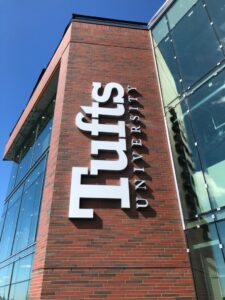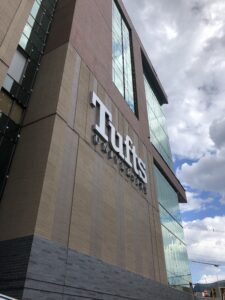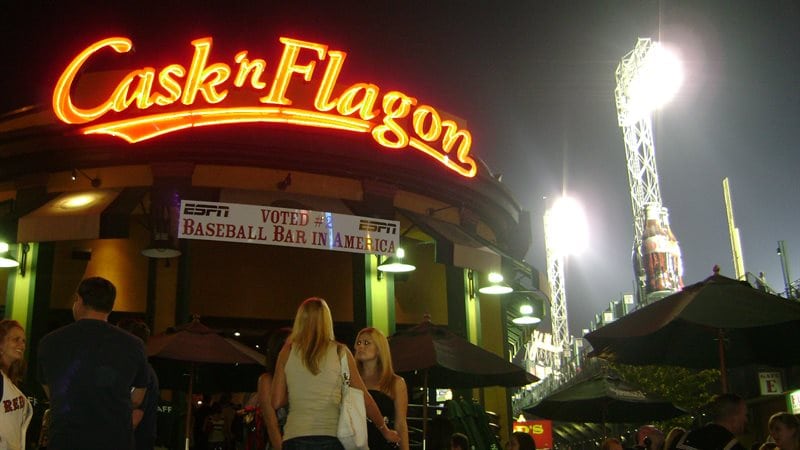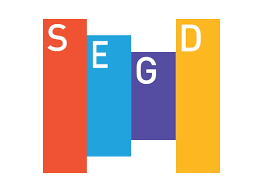Inside Metro Sign
Architectural Signage, Branding, Customer Spotlight, Design/Build, Inside Metro, OthersOne of the easiest ways to get recognition is to put up a sign. We’ve all seen those iconic signs that garner instant attention: The Citgo Sign in Kenmore Square, Cask ‘n Flagon next to Fenway, McDonalds’ golden arches. Target’s bullseye.
A quick glance at these signs tells us immediately what store we’ve found. But these globally recognized icons—like any sign, really—needed serious planning and strategy to work effectively.
Most people—even smart businesses who hire a company like Metro—don’t realize all the steps involved with designing, building, and installing signage. Adding signs requires more than simply hanging a sign on an interior wall or erecting a sign on a pole outside. Developing a signage strategy, from conceptualization through installation, often falls by the wayside at first, but to be most effective, signage planning should be part of the initial process. Signage is a key element of a company’s brand — Metro will happily work with a client’s marketing team to ensure brand compliance and to design a sign that strengthens and promotes the brand.
 This month, we’re going behind the scenes at Metro with designer Dayna McNutt to see what goes into the projects to get them right and create happy clients. A self-taught graphic designer, McNutt has worked in the signage industry for over 20 years, contributing to engineering, fabricating, vinyl production, painting, and interior/exterior installations. Vehicle wrap design and install is her specialty. She says, “Having this background makes it easier to recommend materials, finishes, lighting options, construction, and attachment methods. Even though I came to Metro as a designer, I sometimes cross over to the production/installation side to help when needed.”
This month, we’re going behind the scenes at Metro with designer Dayna McNutt to see what goes into the projects to get them right and create happy clients. A self-taught graphic designer, McNutt has worked in the signage industry for over 20 years, contributing to engineering, fabricating, vinyl production, painting, and interior/exterior installations. Vehicle wrap design and install is her specialty. She says, “Having this background makes it easier to recommend materials, finishes, lighting options, construction, and attachment methods. Even though I came to Metro as a designer, I sometimes cross over to the production/installation side to help when needed.”
The Best Time to Start
Those of us in the signage business know it takes time to do signage well. Signage involves an intricate process including brand analysis, sign design, requirements gathering for construction (attachment methods, power availability, etc.), site surveys, permit research and applications, and so much more. McNutt recommends beginning your signage planning as soon as you know the space into which you’re moving, renovating, or upgrading.
In the beginning stages, our clients speak to one of our salespeople who conduct the preliminary discussion about the project before sending it to the design team. We can provide ballpark pricing up front, which many of our clients need. Larger projects often require us to generate the designs first before we determine the pricing.
Next Metro conducts site surveys, taking photos and measurements, and starting the process to create layouts. Sometimes our clients know what they want. Other times, they’ll lean on us for more guidance. We’ve been in the signage business for 32 years, and with our wealth of experience and deep understanding of branding and signage best practices, we’re happy to provide guidance on designing whatever sign our clients need with an eye toward:
- Cost effective design and cost-efficient marketing
- Aesthetics
- Brand outreach and recognition
- Psychological impact
- Driving strong communications
- Reflecting business quality
- Cultivating a competitive edge
We consider the budget first and often, our designers not only create a design our clients requested but also a few other options we think would be most effective within the given parameters established within the brand.
Once the customer approves the initial designs, we move to the next step.
Where’s it Going? Will it Fit?
Wherever we install an external sign, we must make sure it aligns with local codes, ordinances and bylines. Our designers help the project manager develop a package that fits the code and design.
“We do this step fairly early in the process,” says McNutt, “because we don’t want to get our client’s hopes up if the sign is bigger than what’s allowed. If necessary, we’ll adjust the design to keep it looking aesthetically pleasing and in compliance.”
Given the nature of many of Metro’s clients, the company must occasionally seek variances in historic areas. “If we have a more modern signage project planned for a historic building or building located in a historic area like Back Bay or Beacon Hill, we’ll take pictures of other similar communities moving in a modern direction to take to the variance hearing,” says McNutt. “We explain how signage can help a company gain exposure, and it’s to the community’s benefit that they succeed.
“We have this issue sometimes with signage materials. A historic district may want all its commercial signs manufactured from wood. But Metro also uses a high density urethane (HDU) which is a carved foam for many of the signs we make. And once it’s painted, you can’t tell a sign wasn’t made from wood. Sometimes, the zoning committees don’t understand what we have, the technology we use, and the outcome.
“A lot of what we do is educating people. An HDU sign won’t rot the same way as wood. It won’t need the same kind of maintenance or refinishing. Ordinance meetings offer us a great opportunity to educate, compromise, and get buy-in from the zoning officers,” she says.
Client Approvals Lead to Build Time!
Once McNutt or one of the other designers more fully develops the signage design, Metro sends it to the client for final approval. To keep projects on budget, Metro can value-engineer the designs to take advantage of more cost-effective materials—swapping in acrylic for wood, for example—or recommending standard size letters in lieu of the more expensive custom option.
The entire Metro team understands the variety of available options. Ideas come regularly from sales, design, and estimating because our people in these roles have the most up-front client collaboration. Internally, when someone’s struggling with alternatives, we have an interdepartmental collaboration involving project managers, engineering, production, and sometimes also installation teams to brainstorm solutions. Our team members’ vast range of experiences lends itself to finding a good solution for the many unique challenges we face.
Metro recently launched a new Project Communication System to help facilitate communication between clients and the Metro teams. Designers upload the typically large signage drawings to the system, which alerts clients the designs are ready to review, comment on, and approve. Customers can also upload and send Metro their own files.
After the next round of approvals and once we’ve secured the permits and zoning approvals, the manufacturing department brings the signs to life. One of the designers, like McNutt, makes and sends production files to the necessary Metro department: vinyl and graphics, laser, or the full shop downstairs which includes metal fabrication, woodworking, and the CNC router.
After the Metro teams finish the build, the sign moves to the paint department. Sometimes it requires straightforward painting. Other times, project designs specify special styles or techniques to create a special finish.Bigger signs may need dimensional elements added or vinyl graphics. Everything’s manufactured individually and assembled at the end. The fabricators and painters contribute to this team effort to put together a giant puzzle that evolves into a larger structure. Then it’s scheduled for installation.
Installation
Some installs involve sticking signs to a wall with double-sided tape — but that’s rare. Metro uses its expertise to execute complicated installations involving excavating or erecting signs that stand 30 feet (or more!) in the air. It varies tremendously, McNutt says. When needed, a survey crew will prep the site and for large projects, designers visit, too.
Even with the best of planning, sometimes Metro’s teams find themselves adjusting on the fly. For one parking lot signage installation, they couldn’t measure and cut the signage arms until they arrived on site. For the Tufts signage, one internal wayfinding sign had a floor-mounted plate with a big center pole over which the sign fit. But this tall sign required Metro to bring the right equipment inside—not an issue for the first floor installation in an open area. A definite issue, however, for the sign designed to live on the third floor! Once again, Metro redesigned on the fly.
McNutt says those changes aren’t uncommon, especially with bigger projects when and “almost always when something is designed in advance. It’s something we’re always thinking about,” she says.
 Bringing Vision to Life
Bringing Vision to Life
Ideally, Metro likes to get involved in the beginning, design stages of a build project. This involvement is known industry-wide as “Design-Build.”
“A client’s architect often creates designs in advance,” McNutt says, “but we have to make sure those signs are buildable and aligned with code and the client’s budget.”When they’re involved at the start, Metro can make recommendations to design ideas and anticipate potential issues others not so intimately involved with signage design might not see.
But sometimes, it’s not possible to be part of the process from the very beginning—as was the case with the Tufts University project.
Yet Metro’s collaboration with Roll Barresi & Associates, PROCON, Inc., and others has grown into a solid partnership, even though the team has needed to adjust some of the original designs.
The project included giant channel letters on the side of the building as well as an interior signage package for wayfinding.
An external original design called for 8” deep channel letters with a brushed metal finish mounted on the side of the building. The original size wasn’t standard and would have increased prices significantly, McNutt says, and the original finish cost more to produce, too. In collaboration with the designers, general contractor, and architects, Metro value-engineered an alternative, more cost-effective option to which the university agreed.
“You have to be up front and honest,” says McNutt. “Usually once you start talking budget and making suggestions, clients and other stakeholders understand and agree. For example, with the letters mounted 50 feet above people’s heads, no one would have seen the detail of a brushed metal finish. Painted silver created a similar effect and cost much less, so it was a good compromise.”
The university also wanted to install ¼ inch thick aluminum, painted interior signs which are heavy and expensive. Metro recommended starting with acrylic since it would be covered in paint. After seeing the mock-ups, the university agreed to the change.
Keeping It Safe
 Safety is another critical component to the signage Metro designs & manufactures. The company sends its designs to an engineering company for review and safety verification. Typically, we follow this process for all larger signs, difficult installs, or projects required by a municipality—like projecting signs over a public way. Even smaller signage overhanging a sidewalk need an engineered stamped drawing (ESD) for compliance.
Safety is another critical component to the signage Metro designs & manufactures. The company sends its designs to an engineering company for review and safety verification. Typically, we follow this process for all larger signs, difficult installs, or projects required by a municipality—like projecting signs over a public way. Even smaller signage overhanging a sidewalk need an engineered stamped drawing (ESD) for compliance.
The engineers will provide feedback—and the necessary engineering stamp—after verifying the attachment methods will work. In the case of Tufts’ directories, Metro recognized another necessary change to the sign.
Originally designed as 8 foot tall free-standing directories, they were only 2 inches deep and 24 inches wide. Metro recognized a potential hazard, since they’d be located in public areas. The compromise included extending the base to 5 inches and attaching it to the wall with a hidden wall mount bracket. The sign still looks like it’s floating, but it’s securely fastened.
The Perfect Match
The Tufts project involved a lot of wood. While Metro primarily works on metal fabrication, the project owners wanted interior wayfinding signs to have a white oak veneer, specifically with a rift cut. “The problem we found,” says McNutt, “is that it’s not readily available. We looked for a supplier with the exact wood and type of veneer, and that extended the time frame. We went back and forth with our client, but they’re thrilled with the result and were grateful we took steps to find exactly what they wanted.”
Everyone at Metro takes pride in their work. They get excited to see the results of the final product, because they want to give clients what they want and want them to brag about and take pride in what we’ve delivered.

